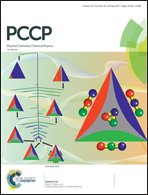On the decay of the triplet state of thionucleobases†
Abstract
Singlet oxygen production upon photosensitization plays a critical role in drugs based on thionucleobases. While for immunosuppressants its yield must be near zero, for phototherapeutic drugs it should be near the unity. In this work, we apply high-level quantum chemical modelling to investigate the decay of the triplet state of thionucleobases, a main determinant of the singlet oxygen yield. Working on CASPT2 optimizations of two prototypical thiothymines (2-thiothymine and 6-aza-2-thiothymine), we showed that the T1 state is characterized by two ππ* minima and by the intersection of T1 with the singlet ground state. On the basis of this topography, we propose a two-step mechanistic model, which, depending on the energetic balance between the two minima, may have as a determining step either a slow transition between minima or a faster intersystem crossing to S0. Chemical kinetics modelling, as well as simulations of the transient absorption spectra, confirmed that the two-step model can explain the experimental results available for both molecules. Moreover, through additional investigations of 2-thiocytosine and 6-thioguanine, we show that such a T1 topography is a common theme for nucleobases. We also discuss how the triplet-state topography may be used to control the singlet oxygen yield, aiming at different medical applications.

- This article is part of the themed collection: 2017 PCCP HOT Articles


 Please wait while we load your content...
Please wait while we load your content...